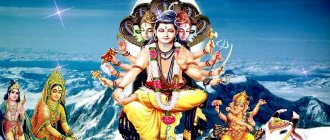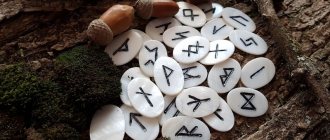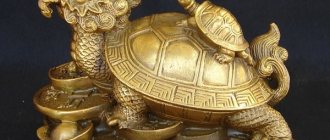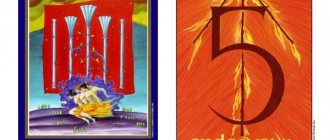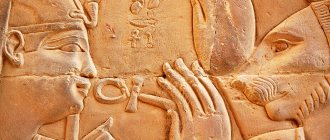Shiva God is one of the most famous and important deities in the Indian pantheon. Together with the divine Brahma and Vishnu, he makes up the famous Trinity of Hinduism - Trimurti.
It is believed that Brahma with Vishnu and Shiva are three hypostases of the One Supreme. Manifestations are associated with the Holy Trinity in Christianity, that is, the Father, Son and Holy Spirit. At the same time, Brahma acts as God the Creator, Vishnu as a protective force, and Shiva as a destroyer.
How many arms does Shiva have?
Shiva is depicted as a deity with four or eight arms . Why does he need so much? The meaning is quite symbolic and has nothing to do with a real person, i.e. he did not have five heads and four arms.
A small Damaru drum is placed in the palms of Shiva - it sounds to the beat of the Universe. The other hand holds the holy fire of Agni, which cleanses and recreates the world anew.
Shiva is also often embodied in statues with a trident. Multi-armedness was not given to this deity by chance. Two hands hold the symbols of Damara and Agni, the others are folded in poses of approval, dominance and strength. The sound of the drum is considered the progenitor of all existing sounds. Thanks to Shiva, the sound “Om” appeared, which later became a mantra. The entire essence of the Universe is concentrated in its sound.
Female image of god
The left side of the deity's torso is associated with the feminine energy of Shakti. Shiva and Shakti are inseparable from each other. The goddess Shiva-Shakti, who has many arms, appears in the image of Kali - the deadly female incarnation of the destructive power of the deity.
Hindus worship the power of Kali. Her face can scare anyone: Kali has blue-black skin, a blood-red protruding tongue and a garland formed by 50 skulls (reincarnations).
One hand of Kali holds a sword, and the other holds the severed head of Mahisha (the leader of the demons). The other two hands express gestures of blessing to all followers, ridding them of fear. Kali is mother nature, who has the power to create and destroy everything in the world with great speed.
Finally, watch the video on the topic:
Image
This god is depicted in white, which signifies spiritual purity . The third eye can be seen in the middle of Shiva's forehead. With the help of it, he can see through space and time - this is a symbol of wisdom.
Another subtlety in the appearance of Shiva is the three stripes on his forehead . They are called tripunda (tripuṇḍraṃ).
One of the interpretations is this: they remind people that they should eradicate egoism (anava), get rid of karma (actions with a view to the result), and illusion (maya). Another interpretation of stripes is getting rid of unnecessary desires:
- at the bodily level, you cannot want to increase your life span, improve your health and appearance;
- on a spiritual level, you need to get rid of vanity, craving for a successful life and wealth;
- At the level of the mind, one should not accumulate unnecessary knowledge, become thoughtful, or experience pride.
Reference! This refers to the excessive focus of the mind in these directions.
For example, when people undergo surgery to look better. Too focused on wealth to the detriment of other areas of life. They gain knowledge only for the sake of knowledge, etc. Three white stripes in the image of Shiva (lingam with tripundra) also meant prisons in the human soul, these are the gunas - Sattva, Rajas and Tamas.
Later, the deity began to be depicted in a sitting or dancing form. One of the main variants of four-armed figurines was the image of Shiva with pale skin and a blue neck. His body is bent in the lotus position and is located on a fur mat; his shoulders are covered with elephant or tiger skin.
The third eye on the forehead is always open. One of the attributes of the deity was also a snake , draped over the shoulder, hanging on the neck or ringing the wrists and ankles. Shiva usually has different earrings in his ears: one for women, the other for men.
Another design of the figurine is Shiva in the form of a dancing deity. This is Nritya-Murti. The number of his hands is unlimited by a certain number. In his palms he can hold various attributes, both peaceful and military. A slain dwarf always lies at the feet of the dancing Shiva. It symbolizes the demon Alasmar-Purusha (illusion).
It is believed that this god lives in the mountains at the top of Kailash. It is there that he manages to immerse himself inside his world.
Shiva embodies severity, renunciation from the outside world. Thanks to the third eye, he comprehends the deep secrets of the Universe. With his palm facing the viewer, Shiva points to the path of liberation of the jiva (personal soul). He removes the shackles that hinder enlightenment.
How to earn the favor of the goddess?
In order for Lakshmi to bring good luck, prosperity, love and mutual understanding to the house, various techniques are used.
The very first thing you need is to pay special attention to the home into which you want to attract the goddess . It is better if we place a figurine of Lakshmi or at least her image in the house. Since Lakshmi is interested in financial affairs and material well-being, and she herself does not tolerate inaction, it is best to place her image in the hallway or study. This is because these parts of the house have a connection with material wealth, financial wealth, and an increase in financial wealth. also advisable to focus on the southeast direction when placing the symbolism of the goddess . The southwestern direction is also allowed as the personification of travel and help.
Modern feng shui experts say that you can put a photo on the desktop of a computer device. It should depict the goddess with those symbols that represent your most pressing needs. There are enough necessary pictures and photos on the Internet.
You should do your best to stop quarreling and not keeping promises . Lakshmi loves when people take responsibility for their actions and take initiative . Special attention should also be paid to the cleanliness of the home. It is necessary to clean it as often as possible. You can periodically light incense sticks (ideally made from lotus and other flowers).
Goddess Figurines
To further appease Lakshmi, an altar should be installed and its surface covered with a beautiful cloth embroidered with gold threads. In its center there should be a figurine or image of this deity. The altar should be decorated with gold items, fresh large flowers, and precious stones (especially red and yellow jade, lapis lazuli).
Lakshmi is compassionate and merciful. She does not tolerate cruel, aggressive, envious and vicious people. therefore, in order to earn her favor, it is important to work on your spirituality.
Lakshmi will never stay where there is anger, hatred, lies, envy, hypocrisy and violence. She is also intolerant of sexual perversions, and therefore does not encourage non-traditional sexual orientations, accompanied by unhealthy hobbies, and the trade in intimate services. She simply leaves this place and does not want to return there anymore. And behind it goes prosperity, well-being, luck and happiness. Life in peace, love, harmony - that’s what she likes. And for this she generously rewards.
Attributes
Shiva has many different attributes. Wandering around India, you can notice completely different statues of the same gods. Knowledge of the symbolism of this country helps to understand all the nuances. Often in the hands of Shiva there are weapon attributes in the form of Ajagava (a special bow), Bhindipala (dart), Gada (rod), Khadga (sword), Khatvanga (club with a skull), Khetaka (shield) and various others. Another significant thing is Trishul’s trident (a symbol of evolution, gunas, three faces of time and other concepts).
Ritual attributes include:
- Chillum smoking pipe;
- Shankha shell;
- mudras (position of hands in special poses);
- a jug with the nectar of immortality Kaumudi;
- cup in the shape of a Kapal skull;
- small drum Damaru (symbol of the Universe from which everything around was born);
- Akshamala's special rosary.
Shiva is characterized by several energies: fire (Agni), the heavenly river (he was able to pacify the Ganga) and the power of Shakti.
The image of the deity is closely associated with animals: the snake Naga, the elephant and the tiger (the skins of these animals and the elephant goad), the white bull (Nandin) and the doe (Krishnamriga).
Shiva has special knowledge that can lift a person above this world and bring him closer to the Highest.
Goddess symbols and their meaning
“I pay respects to the mother of all beings, who emerged from the lotus Sri - her eyes are like lotuses blooming after sleep - she clung to Vishnu’s chest! You are a wonderful power, you are a sacrifice to the gods and a sacrifice to the pitaras, you are the mother, the purifier of the worlds, you are the morning and evening twilight and night, power, well-being, sacrifice, faith, Saraswati!
"Vishnu Purana", book. I, ch. IX, slokas 115–116.
These words describe the Goddess in the Vishnu Purana. However, this is only part of what is said about the lotus-eyed goddess in the writings. They like to depict her in different guises, with different objects and different blessing gestures (the so-called Lakshmi mudra), which have a deep spiritual meaning.
The Indian goddess with many arms is most often shown sitting on a lotus, which is a symbol of motherhood and spiritual purity. Incredibly beautiful, she fascinates, makes you look at every symbol depicted with her.
You can find a variety of pictures in which Lakshmi appears in various images. The goddess of prosperity can be depicted with a different number of hands. And this is not without reason. If she has eight hands, then in them she holds a gada (staff), dhanus (bow), shankha (shell), arrow, ankus (goad), wooden pestle, chakra (wheel), padma (lotus).
If Lakshmi has four arms, then there may be several options:
- Padma (lotus), shankha (shell), gada (rod), chakra (wheel).
- Padma (lotus), lotus, nectar vessel, mahalunga (lemon-like fruit).
- Padma (lotus), sankha (shell), bilva fruit (wooden apple), ambrosia vessel.
- In the upper hands there is a lotus, and from the lower hands gold coins are pouring, or coins are pouring from only one, and the fingers of the other are folded in a blessing gesture.
Lakshmi may also . In this case, she holds a lotus in one hand and a conch shell in the other. With Vishnu, she most often has exactly two hands. In one of them she has a lotus, in the other she has srifala (coconut) or lotuses in each hand. She sits on the snake Ananta, the left thigh of Vishnu or the eagle. Sometimes you can find images showing a goddess with six arms .
It can also be noted that the Indian goddess, or more precisely, the color of her skin, can be described in different ways. It can be pink, golden yellow, white, dark. If Lakshmi is the color of a thundercloud, then this directly indicates that she is the wife of Vishnu, the dark-faced God. The color pink represents Lakshmi's essence as compassion for all living beings, as she is the Mother of all things .
Goddess Lakshmi is often dressed in golden robes, standing or sitting on a blooming lotus flower. Sometimes I come across pictures in which elephants are waist-deep in water next to her. These are Gaji Lakshmi, symbolizing the splendor and glory of the great goddess . By the way, the Lakshmi lotus may be at different stages of opening. And this is not just like that. He personifies beings at different stages of development of consciousness .
So, Lakshmi is the goddess of prosperity and the goddess of wealth, a symbol of love and motherhood, grace and beauty. She is the embodiment of spiritual purity, immortality, good luck, happy destiny. And each Lakshmi symbol has a deep meaning.
Trident of God Shiva
The trident has another name - Trishula. One of the main attributes of a deity. Western mythology has a similar association with Poseidon. He commands the elements of the sea and is always depicted with a trident. In the Buddhist religion, this item has become a symbol of the three jewels of Buddha. The Christian faith is based on the trinity - the Trinity. All this suggests that the number “three” is symbolic for many religions and symbolizes balance and support. In dualism, there is a struggle between two oppositely directed principles, and in trinity, different elements are harmoniously combined with each other. Each principle balances the other two.
The modern system of power also often consists of two opposing forces, as in dualism. But the ancient government of the world often consisted of three political forces, for example, the triumvirate in Ancient Rome. There is no point in dwelling in more detail on the political system; this article has a different task. But in the triuvirate there was still more coherence and stability than in the modern system of public administration. In a democracy, the fight is always between two sides, there is no balance. First one wins, after some time the other wins.
The symbol of the trident contains three aspects, including the modern world: the creator, the preserver, the destroyer in one person. This designation is found in Kashmir Shaivism. It is in this tradition that the listed aspects correspond to Shiva. Other traditional movements attribute creation to Brahma, preservation to Vishnu, destruction to Shiva.
Lakshmi as srivatsa
The word "srivatsa" in Sanskrit means "beloved Sri". This is a curl of hair or an auspicious sign that is located on the chest of Vishnu - the beloved husband of Sri, that is, Lakshmi. This sign testifies to Vishnu's fidelity to his wife. Since Lakshmi is the goddess of wealth and prosperity, it is natural that srivatsa can bring good luck. We also have an interesting article about the Aum symbol.
Srivatsa symbol in different versions
Krishna is the eighth avatar of Vishnu. In the center of his chest is srivatsa. This symbol is also called “nandyavarta”, which translates as “curl of happiness”. It is a combination of hooks forming a Greek cross, or has the shape of a swastika.
The so-called endless knot (granthi) has been known for a long time. It was depicted on clay products 2500 thousand years BC. Buddhism later borrowed this symbol, which is believed to bring good luck.
Spouse
Admirers of Hinduism are familiar with the name of the wife of the deity Shiva - Parvati . In Sanskrit पार्वती, pārvatī? "mountain". This is just one of her names. She is also known as the good form of Devi Shakti (feminine creative energy). Her other good name is Gauri. Hard forms of Devi exist under the names of Kali, Shyama, Chanda, Durga.
In the image of Parvati one can discern the features of Shiva's first wife Sati. She is known as the daughter of the king of the mountain peaks Himavat and the heavenly maiden Menaka Parvati (daughter of the mountains). She later became the mother of the god Ganesha, depicted as an elephant.
According to legend, Parvati should have a child from Shiva who will defeat the demon Taraki. But Shiva was not interested in Parvati and did not appreciate her devotion and unrequited love. Sati ended her life by self-immolation, and Shiva stopped being interested in other women. Sati's soul passed into the form of Uma-Parvati, but he could not figure it out. All attempts by Uma to win the feelings of Shiva were unsuccessful.
Legendary meditation course without payment We recommend! The most popular meditation course for beginners in Russian. More than 100 thousand people have already learned to meditate. Try it yourself. Read more.
The supreme gods feared that no one could defeat Taraki, so they sent Kama to Shiva. With the help of Kama (the god of love), he should have developed feelings for Parvati. Kama shot an arrow of love at Shiva while he was dozing. But Shiva always had a third eye, with which he noticed the arrow and destroyed Kama. Since then, the god of love has no physical incarnation. And Parvati began to engage in asceticism.
One day a brahman came to her and began to scold Shiva. Parvati flew into a rage and rushed at the brahman, protecting her beloved. She did not know that Shiva himself came to her in the form of a brahman. So he wanted to test her loyalty. After this incident, Shiva married Parvati and they had two sons: Ganesha and Skand , who eventually defeated Taraki.
The strongest among the gods
Many Indian legends are dedicated to Shiva and his story. Many of them emphasize the power of God. Once he even entered into a competition with two of his supreme “colleagues”. Shiva turned into a huge pillar of fire, which had no beginning or end.
Then Brahma took the form of a swan and flew high up, but could not reach the top of the sacred Shiva Lingam (pillar). Vishnu, in turn, turned into a boar and began to dig the ground under the pillar. He was never able to reach the bottom. Since then, the gods have recognized that Shiva is the most powerful among them.
Family
Sati became the daughter of Daksha and the future wife of Shiva . Her name is mentioned in Puranic Hindu texts. Sati's fate is tragic. Her father refused to invite Shiva for a significant sacrifice. Then she renounced Daksha and burned herself to ashes with sacrificial fire.
Sati was reborn in the Himavata family (Himalaya mountains) in the form of Parvati (daughter of the mountains). By performing special austerities she managed to win the love of Shiva again.
As a result of mutual feelings, two sons were born to them: Skanda, a warrior deity, and Ganesha, a learned deity. The entire family is called Shiva Parivar. They are depicted with four hands, in which they hold various attributes and vahanas. Indian mythology idealizes the trinity of Shiva-Parvati-Ganesha. This is how the divine family is embodied. Some texts mention another child of Shiva - daughter Manasi.
Parvati's sister (Ganga) is also considered the wife of Shiva. According to the Vedas, Ambika is called the sister of Rudra (Shiva), but in later literature she began to be identified with the wife of Shiva.
Numerous names of the Goddess
Lakshmi has many names, each of which has a specific meaning. Her sacred name is the name Sri, translated from Sanskrit as “prosperity”, “happiness”. In the Vishnu Purana, various shlokas and puranas of ancient scriptures, the goddess is called exactly that and is given the role of Mother of the world.
The Skanda Purana, which describes the life path of Kartikeya (the son of Shiva and Parvati), lists the names of Lakshmi. Surprisingly, in it you can find references to 1008 names of the goddess! They are also called Lashkmi-sahasranama. They are read on Fridays early in the morning. The names of the Indian goddess are also described in the Brahma Purana.
Here are just some of the names of Lakshmi (the most traditional) and their meanings:
- Srija - Born in prosperity;
- Kamala, Padmasundari - Beautiful as a lotus;
- Padma - Lotus-like;
- Padmapriya - Loving lotuses;
- Padmahasta - Holding a lotus;
- Padmamaladhara - Wearing a lotus garland;
- Padmakshi - With beautiful eyes like a lotus;
- Padmamukhi - With a beautiful face like a lotus;
- Jagadishwari - Mother of the world;
- Ulkavahini - Moving on an owl;
- Vishnupriya - Vishnu's Beloved
Other, not so popular names of Lakshmi: Aishwarya, Mohini, Lalima, Indira, Nandika, Nandini, Sridevi, Madhavi, Shriya, Tripura, Malti, Devi, Savitri, Aruna, Akhila, Avashya, Sita, Sharanya, Anumati, Durga, Rujula, Sujata, Jalaja, Bala, Kriyalakshmi, Kamalika and many others.
Functions
- Shaivism assumes the role of the supreme god Parashiva - the creator, destroyer, defender of truth, conqueror of demonic forces, giver of goodness and ruler of the entire Universe, all other deities are subordinate to him;
- in Hinduism, Shiva is considered the destroyer of all things: when the world cycle (Mahayuga) comes to an end, he will clear the space to create a new world;
- he is known as the creator of the sound “OM”, as well as Sanskrit and pagan cult;
- this deity also has healing power, it is able to deliver from death (Mahamrityunjaya);
- his retinue includes spirits and demonic forces that follow him on his heels at will.
What is the danger of a many-armed God?
By his nature, Mahadeva is dual: at the same time he acts as both a creator and a destroyer. At the end of its cycle, the Universe must be destroyed. But if Lord Shiva is angry, he can do this at any moment.
A similar thing happened when Sati died in a fire. Then God became bloody and cruel. He, experiencing the hypostasis of Virobhadra, reproduced himself in thousands of people and went to the palace of Sati’s father for retribution. In anger, he killed everyone around him and cut off the head of Daksha, the culprit behind the death of his beloved. Rivers of blood flowed across the ground, the sun became faded. But the god’s anger passed, and he resurrected all the dead, and Dakshi set up the head of a donkey.
Temple
The city of Baijnath in India is famous all over the world for the temple of Lord Shiva. It was built in the thirteenth century and was named after one of the deity’s names – Vaidyanath, which translated means “patronage of healers.”
Once upon a time there was a shrine of Shiva in this place. The rich people of the city wished to perpetuate themselves in the memory of the people and created a new grandiose building on the holy place. These merchants' names were Ahuk and Manyuk. Nowadays, crowds of parishioners and tourists make pilgrimages to the temple.
The outside of the building is surrounded by a wall with two entrances. Shiva was depicted inside the structure as a multi-armed deity (lingam). It is interesting to note that the locals consider this image to be svayambhu (self-created). The walls of the temple are decorated with bas-reliefs of gods from the Hindu pantheon.
The entrance to the building opens with a statue of Nandi (white bull). According to legend, Shiva often rode a bull. The statue is a symbol of pure dharma, sincerity, devotion and courage.
Misperception
In the West there are cults of satanic and mystical directions. They not only misperceive, but also describe the Black Goddess by comparing her to the Egyptian deity Set. She is portrayed as a merciless killer and cruel bloodsucker who consumes the flesh of her many victims.
Goddess Kali has countless forms, images and incarnations. She is always mysterious and can be both terrifying and attractive. She disturbs the soul, and her faces leave no one indifferent. Kali has absorbed all conceivable manifestations and forms of the divine principle - from the angry and downright terrifying to the most attractive and merciful.
Holidays
One of the most famous festivals associated with the name of Shiva is Mahashivaramtri . This is the great night of the deity: festive festivities last throughout the night on the eve of the new moon on the last day of the lunar cycle of winter. This happens in February-March.
During Shivaratri, kathas (tales about Shiva) are read and hymns are sung in his honor. Festive events take place several times throughout the year, but this particular day is considered the most important, therefore the prefix Maha (great, main) is added to the word Shivaratri.
After the end of the holiday, the fair begins its work, taking place near rivers and reservoirs. Whoever was able to stay awake during the festivities will experience material well-being and a heavenly place in heaven.
Meditation on such a day brings a hundred times more benefits than on any other. This is related to the favorable placement of the Sun and Moon.
The symbol of the festive event is the lingam.
Shiva is known to many for his dancing image, so during the festivities everyone performs his Tandava. This is a special dance, considered a symbol of the movement of the world. Everything that exists is born from this dance and ends with it. While Shiva is dancing, the world exists. This god embodies the highest degree of bliss - Ananda.
Who does Lakshmi protect?
The many-armed goddess Lakshmi is a reliable support for those who are engaged in creativity and have connected their lives with this direction . She loves no less those who have found themselves in a profession related to the production of clothing or household items, cosmetology, finance, jewelry making, raising children, cooking, farming, and social assistance. Perhaps it is simply impossible to list all the areas of activity under the patronage of the goddess.
It is also worth remembering that Lakshmi can be both infinitely kind and merciful and angry - however, quite deservedly. She doesn't like it when people are too greedy and when, on the contrary, they waste too much money . If a person shows disrespect for food, has an unkempt appearance, there is dirt and strife with relatives in his house, conflicts at work - Lakshmi will turn away from such a person . She also does not encourage the killing of animals, poor treatment of natural resources, or the destruction of beautiful things.
Particular attention should be paid to wearing gold. If this is done incorrectly, luck, happiness and material well-being can turn away from a person. Since gold is one of the manifestations of Lakshmi and the Sun God (Surya), it must be treated with respect . You should not wear it on your ankles as a bracelet, as this part of the body is considered dirty. At the same time, the goddess does not limit the desire of both women and men to wear gold jewelry on any other parts of the body.
Lakshmi values courage, strength, the ability to withstand powerful opponents and win in the fight against them. The goddess patronizes people who are able to show determination.
The lotus-eyed goddess shows women by her own example how they should treat their spouses. They must honor their husbands as gods, remain faithful to them, always be wonderful housewives, attractive, and homemakers. At the same time, a grateful husband will surround his wife with care, attention, and give her what she wants.
